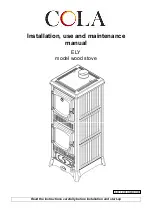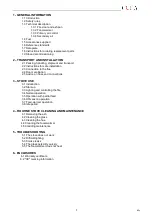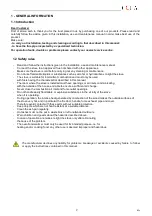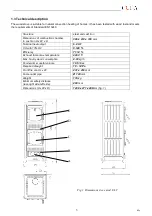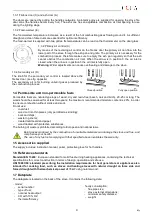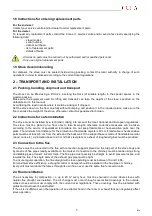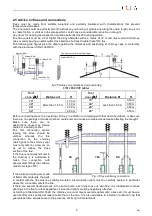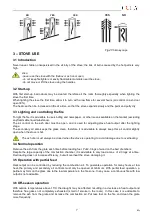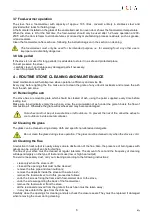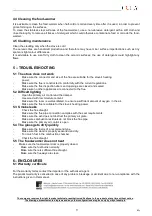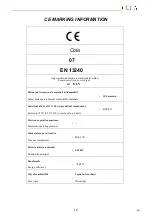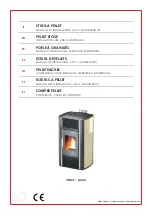
5
Ely
1.8 Instructions for ordering replacement parts
For the end-user:
Contact your service centre and/or dealer to order replacement parts.
For the dealer:
To request any replacement parts contact the Cola s.r.l. service centre and/or send a fax clearly specifying the
following data:
-
stove model;
-
serial number;
-
date of purchase;
-
list of replacement parts;
-
details of faults.
- All work on parts must be carried out by authorised and/or qualified personnel.
- Only use original replacement parts
1.9 Stove decommissioning
For disposal, the stove must be sealed inside strong packing; contact the local authority in charge of such
operations in order to proceed according to the current local regulations.
2 – TRANSPORT AND INSTALLATION
2.1 Packing, handling, shipment and transport
The stove can be lifted using a lift truck, inserting the forks (of suitable length) in the special spaces in the
wooden packing.
Make sure the equipment used for lifting and transport can take the weight of the stove, specified on the
dataplate and in this manual.
Avoid taking the load in areas where it could be a danger if dropped.
Set the stove down on the floor carefully without bumping, and position it in the required place; make sure the
floor can take the weight of the stove, otherwise contact a specialised technician.
2.2 Instructions for safe installation
The stove must be installed by a technician, taking into account the local, national and European regulations.
The stove must be placed on a floor able to take its weight; otherwise corrective measures can be taken
according to the advice of specialised technicians. Do not keep flammable or heat-sensitive parts near the
glass. The minimum front distance for the protection of flammable objects is 80 cm. Flammable or heat-sensitive
parts must be at least 20 cm from the side and the back wall. If the support base is made of flammable material
(wood, cork, etc.) a protection base in 2-3 mm thick steel plate or a sheet of toughened glass must be provided.
2.3 Connection to the flue
The stove must be connected to the flue with connection supports placed on the top part of the stove body and
by means of flue pipes readily available on the market. Connection to the chimney must be made using strong
and stable pipes at least 1.2-2 mm thick. The flue pipe must possibly be straight, to avoid pressure losses, and
towards the flue. The single parts of the exhaust gas pipe must be tight.
To ensure regular operation, the flue draught with stove operating must be between 10 and 14 Pa.
For maximum stove efficiency, a draught control or damper should be installed in the flue pipe or chimney.
Every unit must eliminate the fumes through its own flue; never use the same flue for several units.
2.4 Room ventilation
The air necessary for combustion, i.e. up to 20 m³ every hour, must be ensured in rooms where stoves with
natural flue draught are installed. The air change must occur through several fixed openings to the outside,
whose cross section must comply with the current local regulations. These openings must be protected with
grilles and must never be obstructed.
If the air is insufficient, even the operation of an extractor hood in the room or exhaust fans can negatively affect
stove operation.

